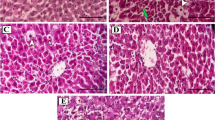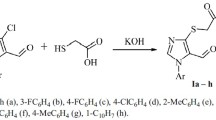Abstract
In human beings, poisoning by the deathcup mushroom causes renal lesions in addition to extremely severe liver damage. It is known from animal experiments that silymarin, a polyhydroxyphenylchromanone, is capable of counteracting this α-amanitin-induced liver damage. The purpose of the present work was to ascertain whether renal damage could be induced in rats by giving α-amanitin, and whether silymarin would have any effect on such renal damage. The fact that α-amanitin produces pathological changes in the kidneys and that these lesions can be almost completely prevented by pretreating rats with silymarin has now been amply demonstrated by biochemical and histological techniques alike.
Similar content being viewed by others
References
S.K. Abul-Haj, R.A. Ewald andL. Kazyak,Fatal Mushroom Poisoning. Report of a Case Confirmed by Toxicologic Analysis of Tissue, New Engl. J. Med.269, 223–227 (1963).
F. Skrabal andP. Dittrich,Hämodialyse bei Amanita-phalloides-Vergiftung, Wien. klin. Wschr.85, 590–592 (1973).
J. Lough andD.G. Kinnear,Mushroom Poisoning in Canada: Report of a Fatal Case, Canad. med. Ass. J.102, 858–860 (1970).
H.E. Bock, H. Nieth, E. Zysno, J. Gayer andC. Fröhlich,Die Knollenblätterschwamm-Vergiftung. Symptomatologie, Klinik, Therapie, Dtsch. med. Wschr.89, 1617–1622 (1964).
H. Thölen, T. Fröhlich, F. Huber andM.A. Massini,Frühzeitige Hämodialyse bei Vergiftung mit Amanita phalloides, Dtsch. med. Wschr.90, 1364–1366 (1965).
J. Kubička andA.E. Alder,Ueber eine neuere Behandlungsmethode der Vergiftungen durch den Knollenblätterpilz, Praxis57, 1304–1306 (1968).
R. Zulik, F. Bako andA. Kisbán,Zur Behandlung der Knollenblätterpilzvergiftung, Med. Klin.68, 1371–1372 (1973).
E.G. Krienke,Knollenblätterpilz-Vergiftung, Dtsch. Ärztebl.72, 2251–2256 (1975).
K. Ziegler, J. Dabels andL. Pelz,Knollenblätter-pilzvergiftungen im Erwachsenen- und Kindesalter unter Berücksichtigung neuerer Behandlungsverfahren, Dtsch. Gesundh.-Wes.19, 1674–1680 (1964).
G. Weil andM. Frimmer,Die Wirkung von Silymarin auf die mit Phalloidin vergiftete isolierte perfundierte Rattenleber, Arzneimittel-Forsch.20, 862–863 (1970).
F. Stirpe andL. Fiume,Effect of α-Amanitin on Ribonucleic Acid Synthesis and on Ribonucleic Acid Polymerase in Mouse Liver, Biochem. J.103, 67P-68P (1967).
F. Stirpe andL. Fiume,Studies on the Pathogenesis of Liver Necrosis by α-Amanitin. Effect of α-Amanitin on Ribonucleic Acid Synthesis and on Ribonucleic Acid Polymerase in Mouse Liver Nuclei, Biochem. J.105, 779–782 (1967).
J.J. Morrissey andW. Lovenberg,Synthesis of RNA in the Pineal Gland During N-Acetyltransferase Induction. The Effects of Actinomycin D, α-Amanitin and Cordycepin, Biochem. Pharmacol.27, 557–562 (1978).
T.J. Lindell, F. Weinberg, P.W. Morris, R.G. Roeder andW.J. Rutter,Specific Inhibition of Nuclear RNA Polymerase II by α-Amanitin, Science170, 447–449 (1970).
A. Buku, G. Campadelli-Fiume, L. Fiume andT. Wieland,Inhibitory Effect of Naturally Occurring and Chemically Modified Amatoxins on RNA Polymerase of Rat Liver Nuclei, FEBS Letters14, 42–44 (1971).
C. Kedinger, M. Gniazdowski, J.L. Mandel, Jr., F. Gissinger andP. Chambon,α-Amanitin: a Specific Inhibitor of One of Two DNA-Dependent RNA Polymerase Activities from Calf Thymus, Biochem. biophys. Res. Commun.38, 165–171 (1970).
W. Romen, U. Knobloch andH.-W. Altmann,Vergleichende Untersuchungen der Kernveränderungen von Rattenhepatocyten nach Actinomycin D- und α-Amanitin-Vergiftung, Virchows Arch. B Cell Path.23, 93–108 (1977).
R. Seeger,Giftpilze und Pilzgifte, in:Allgemeine und spezielle Pharmakologie und Toxikologie (Eds. W. Forth, D. Henschler and W. Rummel; Bibliographisches Institut, B.I.-Wissenschaftsverlag Mannheim/Wien/Zürich, 1975), pp. 591–595.
T. Wieland,Struktur und Wirkung der Amatoxine, Naturwissenschaften59, 225–231 (1972).
G. Vogel, W. Trost, R. Braatz, K.P. Odenthal, G. Brüsewitz, H. Antweiler andR. Seeger,Untersuchungen zu Pharmakodynamik, Angriffspunkt und Wirkungsmechanismus von Silymarin, dem antihepatotoxischen Prinzip aus Silybum mar. (L.) Gaertn., Arzneimittel-Forsch.25, 82–89, 179–188 (1975).
L. Fiume, V. Marinozzi andF. Nardi,The Effects of Amanitin Poisoning on Mouse Kidney, Brit. J. exp. Path.50, 270–276 (1969).
H. Bülles, J. Bülles, G. Krumbiegel, W.H. Mennicke andD. Nitz,Untersuchungen zur Verstoffwechselung und zur Ausscheidung von Silybin bei der Ratte, Arzneimittel-Forsch.25, 902–905 (1975).
W.H. Mennicke,Zur biologischen Verfügbarkeit und Verstoffwechselung von Silybin, Dtsch. Apoth.-Ztg.115, 1205–1206 (1975).
Author information
Authors and Affiliations
Rights and permissions
About this article
Cite this article
Vogel, G., Braatz, R. & Mengs, U. On the nephrotoxicity of α-amanitin and the antagonistic effects of silymarin in rats. Agents and Actions 9, 221–226 (1979). https://doi.org/10.1007/BF02024739
Received:
Issue Date:
DOI: https://doi.org/10.1007/BF02024739




